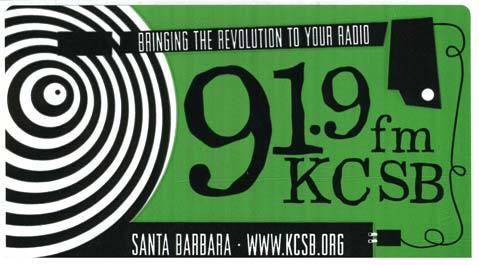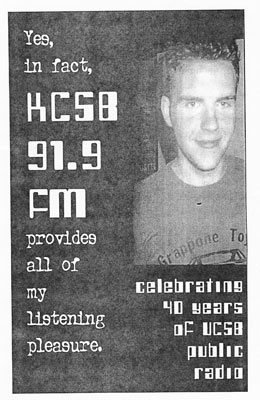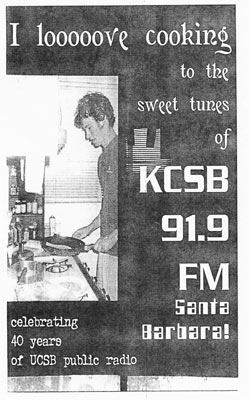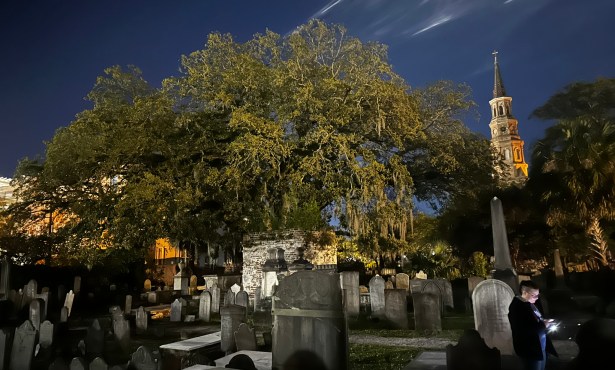E Pluribus, Unum KCSB
A Brief History of KCSB, Part VIII

As humanity closes out the 2000s by taking stock of what’s been gained and lost in the past decade, so The KCSBeat shall follow suit. Conveniently, that’s what this column would have done anyway: Its not-quite-all-that-brief-anymore history of KCSB has coincidentally reached what is, for now, its final chapter. The KCSB of the 2000s is the KCSB we know today: varied, experimental, prone to change things up every few months, a container of multitudes.
2001 saw the station take advantage of opportunities afforded by the internet, overhauling its theretofore fairly static web site and upgrading its web servers to offer listeners worldwide the ability to tune in via an online stream. This meant that former KCSBers could keep up with the station even if they’d long since fled Santa Barbara. This would have prepared the far-flung attendees of KCSB’s 40th anniversary reunion, held in 2002 in Oak Park, or its 45th in 2007. You wouldn’t think DJs of decades past would necessarily rush back over great distances to their old college station and reminisce, but then, KCSB has that effect on people.

The station’s life-touching reach extended beyond UCSB students and radio-inclined community members in the early 2000s with the Youth Radio Project. This effort brought the underrepresented high school-aged kids of Santa Barbara County into the studio to produce weekly KJUC programs on subjects like activism, news during wartime, sexuality, and music, and in the process to learn about how media is produced and consumed. Some Youth Radio alumni returned, as full-fledged KCSB broadcasters, to train even more youths themselves.
While continuing to educate its contributors and listeners about how to use the news media, KCSB began to produce much more news of its own after a 2002 grant from the Fund for Santa Barbara allowed the station to hire its first full-time news and public affairs director.
How to form a community news team of one’s own was just one of the topics covered in the June 2004 Grassroots Radio Conference in Los Olivos, a four-day conference presented by the Grassroots Radio Coalition and KCSB. The 250 attendees participated in workshops on team building, music mixing, station building, national policy issues affecting broadcasters, the mission of community radio, addressing privilege and inequality, and how best to take advantage of new computer and electronic technologies-an area where the KCSB of the 2000s was accruing much experience of its own.
Despite the excitement of harnessing the rapidly developing technical advantages to community broadcasting which the Internet provides, KCSB still had to deal with the normal wear-and-tear issues that have always plagued community radio stations. Mechanical failure, gear obsolescence, tower corrosion: It all happened. By 2002, this natural process necessitated the construction of a robust new tower at Broadcast Peak with an equally robust price tag. Not helping to defray this cost was the dish failure of November 2004, which temporarily derailed the station’s annual pledge drive.

Nevertheless, the station put out a better-sounding signal than ever in 2005 when it acquired a host of improved gear, including a slick new mixing board. (Though no KCSBer would dare speak ill of the beloved old console, its replacement came not a moment too soon: What dim recollections of it remain invariably include that much of it was made of wood.) The station was thus well-placed to earn accolades for its excellence as a student organization from UCSB’s Office of Student Life, and as an emergency broadcaster during the fires Tea and Jesusita.
And the technical advancement hasn’t stopped: KCSB recently introduced a media center to foster integration with other forms of communication and expression, an online store for the convenient purchase of KCSB paraphernalia, and programming in that most on-demand of all forms, the podcast.
The 2000s also happen to be where I came in. Half-smothered under the dreaded college application process, I visited UCSB in 2002, taking a tour despite having all but decided I didn’t want to go there. When the guided portion of the afternoon ended and I began wandering the campus, what did I stumble upon but… a radio station? Not realizing that any college-based freeform stations still existed, I asked around and confirmed that, yes, with a little training-and a little willingness to work the 4 a.m. time slot-I too could helm a real radio show. At that moment, it was settled. I could spend my collegiate life at one place and one place only: KCSB. Uh, I mean, UCSB. Yeah, that’s it.
I’m glad to be a part of KCSB’s latest iteration and most modern phase. My experiences behind the mic as well as in the historical archives reveal that KCSB is and has always been an expression of the people who comprise it. What began as a haven for young electronics wonks eager to learn the mechanics of radio turned into a home for classical music aficionados which turned into a vehicle for fledgling news reporters which turned into a showcase for rockers and their craft which turned into a forum for social activists. Though it’s bad form for a historian to get teleological, the obvious conclusion is hard to resist. Perhaps all this evolution has led to the ideal KCSB: the KCSB for everybody.



